Aventon Pace 500.3 Review | Hello, Torque Sensor Upgrade!
Comfort, style, capability, and speed combine in this new-and-improved city cruiser!
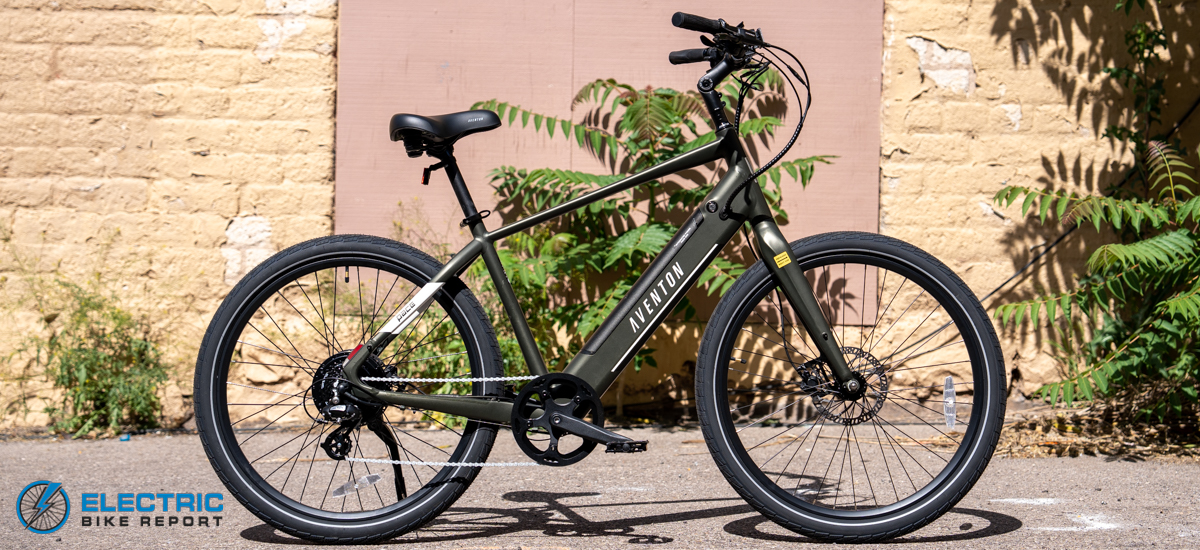
This third iteration of the bike features a couple of small upgrades that make a massive difference:
Aventon replaced the old cadence sensor with a torque sensor that greatly improves the bike’s ride and responsiveness. And the addition of turn signals adds an additional layer of safety by increasing rider visibility.
The Pace 500.3 retains the 500.2’s dutch-inspired, cruiser geometry, which places the rider in a comfortable position and gives them a broad view of their surroundings. This makes the bike well-suited to occasional riders and daily commuters alike.
Keep scrolling to see our full Aventon Pace 500.3 HS review!
 Pros
Pros- A more responsive/natural ride feel and great range! The upgrade to a torque sensor results in a ride experience similar to a non-electric bike, and also makes the bike’s motor and battery more efficient!
- Turn signals! The Pace 500 now includes taillights and turn signals integrated into the seat stays for better safety and rider visibility.
- A comfortable ride! Upright, dutch-styled rider positioning means you get a great feel and a broad view of your surroundings.
- Speed when you want it. The bike’s 500W rear hub motor feels a lot more powerful and zippy than it is.
- Great handling and maneuverability! A low weight of just 52 lbs makes it easy to get up to speed, weave through traffic, and load the Pace 500 on a bike rack.
- Great for commuting to work or cruising on casual weekend rides.
- Great looks. This may be subjective, but we really dig the Pace 500.3’s contemporary styling and unique “camoflauge” color option (it comes in black too).
- Can be unlocked to Class 3 speeds of up to 28 miles per hour through the Aventon App!
 Cons
Cons- The Pace 500.3 performed well with a good average stopping distance in our Brake Test, but we noticed the rear wheel had a tendency to lock up and slide uncomfortably when braking hard.
- We love the standard color LCD screen, but it can be difficult to read in direct sunlight even in its highest brightness setting.
- Battery : Removable Internal Lithium-ion 48V 12.8Ah (614Wh) with LG cells
- Display: LCD Smart Easy Read Display with Backlight, Colorful screen
- Motor: 500W 48V Brushless Hub Motor
- Headlight: Included
- Taillights: Integrated w/ turn Signal Functionality
- Pedal Assist: 4 Levels
- Range: Up to 60 Miles on PAS, 30 miles on Throttle (claimed)
- Throttle:Throttle on demand – Throttle from a complete stop
- App:Pairs with Aventon App
- Claimed weight: 52 lbs
- Maximum weight limit: 300 lbs
- Brakes: Hydraulic Disc Brakes
- Fenders: Not Included
- Fork: AE-E08-V2 AL Fork
- Frame: 6061 Single-Butted Aluminum Alloy with Fully Integrated Battery
- Drivetrain: 8-speed w/ 48T chainring and 12-32T cassette
- Grips: Ergonomic Comfort
- Saddle: Aventon Saddle
- Handlebar: Aluminum 31.8mm, Sweptback
- Kickstand: Included, Rear Mount
- Pedals: 9/16′ Alloy Platform
- Tires: 27.5″ x 2.1″ Puncture Resistant, Reflective Sidewalls
Aventon Pace 500.3 HS Review: E-Bike Overview
In addition to providing improved motor responsiveness and general ride feel, the addition of a torque sensor also increases the efficiency of the bike’s pedal-assist system. The Pace 500.3 comes with a 48V, 672 Wh battery that isn’t anything remarkable in terms of capacity, yet the bike is able to extend its power reserves to achieve an impressive amount of range.
The second version of the bike included brake lights integrated into its seat stays, but Aventon has further improved this design by adding rear turn signals to the 500.3. We love seeing turn signals on any e-bike – they’re a relatively small addition when there’s already an onboard electrical system – but we consider them to be an essential feature for safety and communication when meandering through city traffic on busy streets. More visibility is always a win!
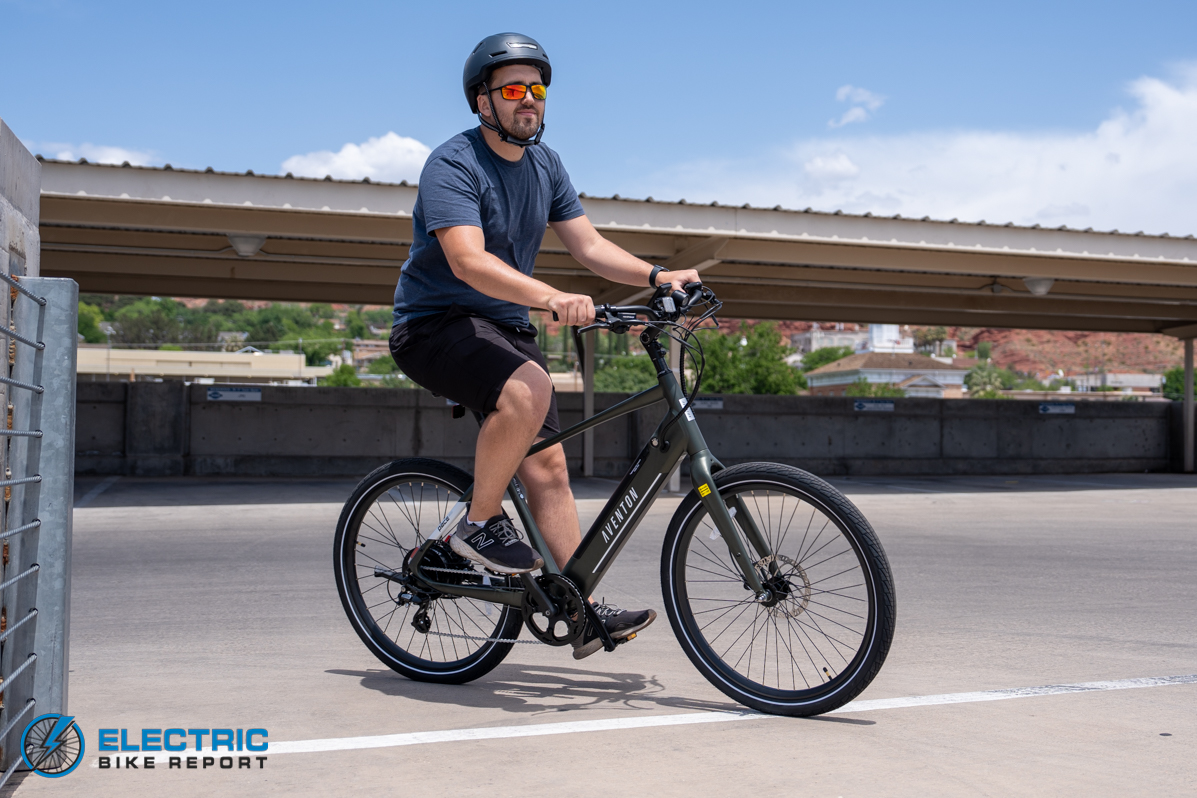
We think it’s pretty obvious that the Pace 500.3 is a looker!
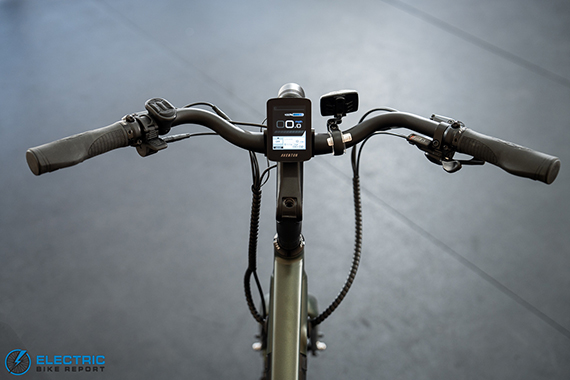
As a cruiser-style e-bike, the Pace features moderately swept-back handlebars and a relaxed riding position.
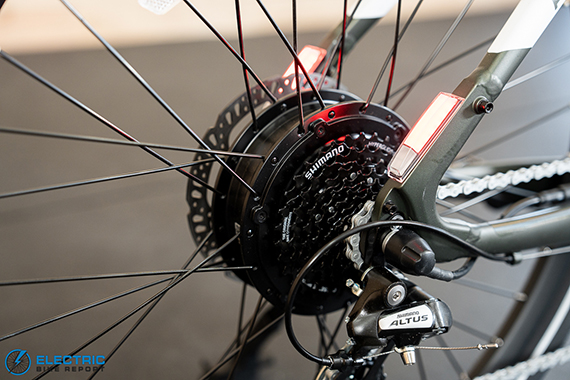
Turn signals and a torque sensor are awesome upgrades that enhance the bike’s ride feel and capability.
As with any e-bike, the Pace 500.3 still has some aspects that aren’t perfect – most notably its handling when braking. The bike performed well when looking at the numbers, but we noticed that it could be difficult to maintain control of the bike when braking hard.
Many city-capable e-bikes (and non-electric bicycles) place their riders at a forward lean for better aerodynamics, but some cyclists may not find this riding position comfortable over long periods of time. The Pace 500.3 has maintained the upright geometry of its predecessors, which makes its rider more visible to motorists, provides a better vantage point to observe the road, and is just generally more comfortable!
In the next sections, we’ll examine the bike’s performance in our array of tests, and put those results into context with its specs and components. Read on to see how the Pace 500.3 HS stacks up!
Aventon Pace 500.3 HS Review: Circuit Speed Test
To evaluate the Pace 500.3 High Step’s motor, torque sensor, pedal-assist system (PAS), and handling, we performed our Circuit Test through the process explained above.
Considering that the bike weighs just 52 lbs – on the lighter side for an e-bike – we expected it to be easy to pedal with no assistance from the motor. We found that it’s certainly possible to move the bike with just leg power, and it’s easier than we’ve experienced on heavy fat tire bikes, but we doubt it’s something you’ll want to do for long distances.
When we engaged the PAS, the motor responded immediately thanks to the bike’s torque sensor. Even in its lowest PAS setting, Eco mode, the Pace felt capable and speedy; as shown by our data, it was able to maintain an average speed of over 17 mph. The motor provided more power (resulting in higher average speeds) in each lap as we increased the PAS setting through Tour, Sport, and Turbo modes, but the differences felt most obvious when getting up to speed.
Interestingly, the average speed results we measured with the HS version of the bike differ fairly significantly from those of the Pace 500.3 Step-Thru model we recently reviewed. This is a side effect of the bike’s torque sensor; different test riders have different riding styles and pedaling speeds, and the torque sensor allows the bike’s motor to match its rider’s level of effort. As such, the Pace 500.3 HS is capable of achieving high speeds in any setting with enough effort applied.
We measured the bike’s performance in this test (and all others) with Class 2 factory settings that limit its speed to 20 mph – though we did also unlock the bike to its maximum pedal-assisted speed of 28 mph (Class 3 mode) through the Aventon App. As a Class 3, it still took some leg work to reach the bike’s top speed; for us, comfortable pedaling in Eco mode placed us around 23-24 mph, with faster speeds easier in higher PAS settings.
The Pace 500.3 HS includes an 8-speed drivetrain that had enough flexibility to work well at all speeds and PAS settings. The low gears were comfortable for hill climbing in Eco mode, and the high gears were functional even at 28 mph in Turbo mode without requiring an excessively fast cadence.
All-in-all, we appreciated the maneuverability of the bike and its speed potential across all of its settings. The bike’s 500W rear-hub motor seemed more powerful – and more capable of reaching the top end of its speeds – than we expected. But the Pace 500.3 is neither a speed demon nor a slouch by its own merits; it’s able to respond to and meet you wherever you feel comfortable. That makes for a winner in our book!
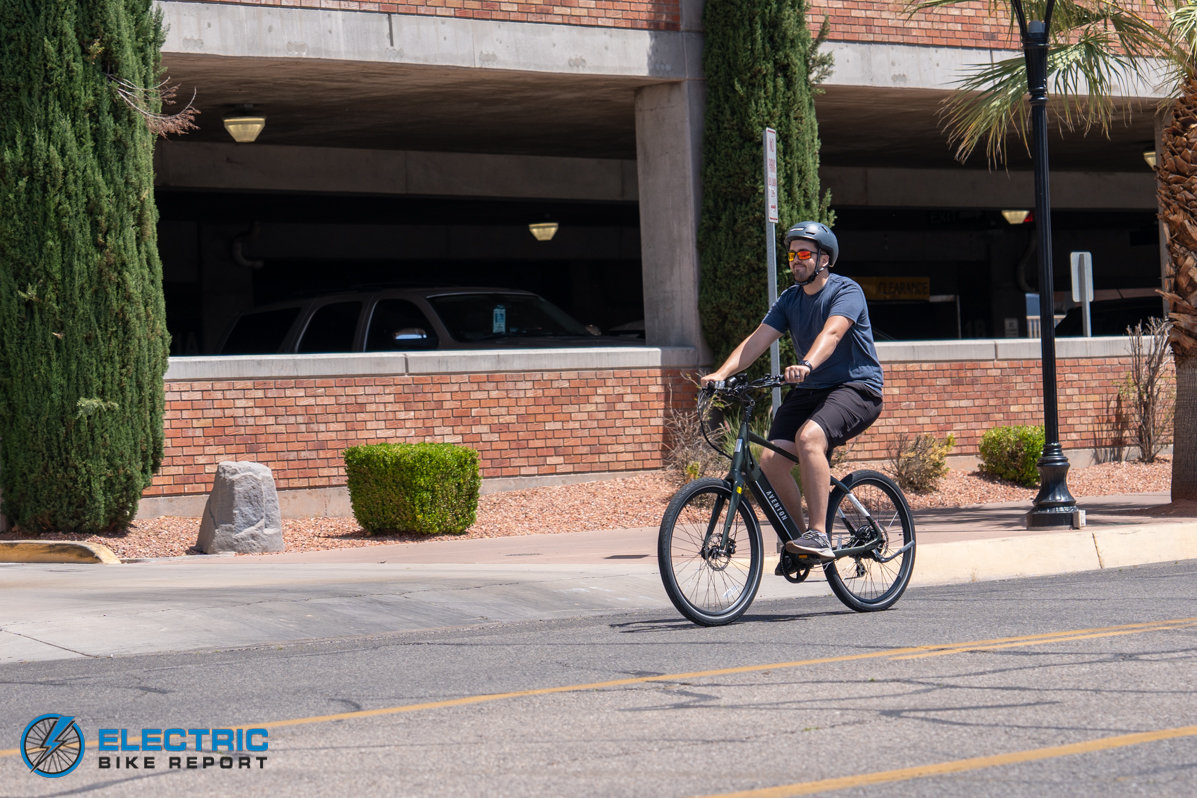
With a real-world range of between 43 and XX miles, you can commute or cruise in comfort.
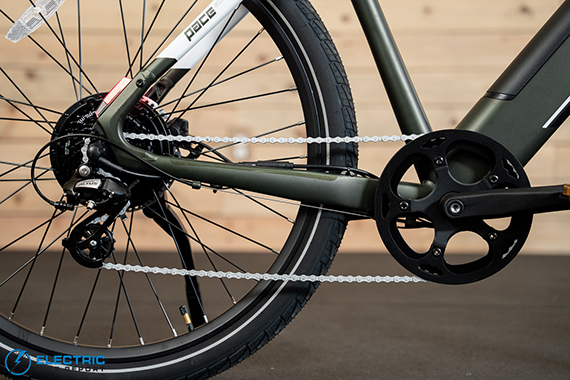
The 8-speed Shimano drivetrain offers a comfortable gearing range for everyday use.
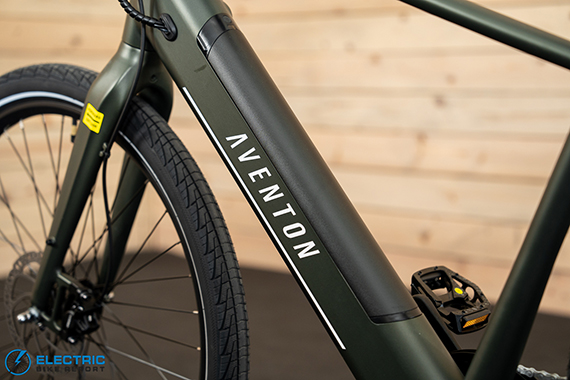
The bike’s 48V, 614 Wh battery is integrated smoothly into its down tube.
Aventon Pace 500.3 HS Review: Range Test & Battery Performance
Aventon advertises a range of up to 60 miles on the Pace 500.3, as measured during their own range testing with the bike limited to Class 2 speeds, in Eco Mode, on flat ground, and with a 160-lb rider.
We evaluated this claim through two separate Range Tests, which are explained in the graphic above. Our results in this test showed a low- and high-end bracket of roughly 35 miles (using the maximum amount of motor power in Turbo Mode) to 68 miles (with the minimum amount of power in Eco Mode).
A quick disclaimer: this specific data was gathered using the step-thru version of the bike. The only difference between the two is the additional material of the top tube on the high-step frame, which should have a negligible impact on range.
These results easily met our expectations – and even exceeded them – for a few reasons. First, simply because we were able to achieve a better range than advertised.
Second, the Pace performed incredibly well when compared to similar e-bikes we have tested. Its results in Turbo Mode greatly surpassed the performance of its competitors (see the comparison graph above), and its results in Eco Mode were only slightly less remarkable. Furthermore, when compared to the previous iteration of the bike, the 500.3 achieved between 15% and 65% better range depending on the pedal assist setting!
Third, and more technically – the Pace 500.3 demonstrated that its motor and battery pairing was surprisingly efficient. We explain this in more detail in our guide to e-bike batteries, but the ratio between a motor’s watt output and a battery’s watt-hour rating is important. We typically prefer at least a 1:1 ratio between these numbers, which the Pace’s 500W motor and 48V, 614 Wh battery exceeds. Based on these numbers, we expected the bike to travel roughly an hour and 15 minutes in Turbo mode, but we were able to travel for almost exactly two.
Much of the Pace 500.3’s efficiency and good range can be attributed to its torque sensor. Since this results in the bike’s motor splitting the effort with its rider, it doesn’t need to draw so much power from the battery. This extends the amount of charge the battery holds, which lengthens the distance the bike can travel.
In the big picture, the Pace 500.3 can travel a significant amount of distance that will likely cover a long commute, a handful of leisurely cruises, or quite a few short workout sessions.
Aventon Pace 500.3 HS Review: Hill Test
By the numbers, the Pace 500.3 High Step’s performance in our Hill Test (explained above) was relatively unremarkable – but not unexpected for a bike with a 500W rear-hub motor.
In the Circuit Test section above, I mentioned that the bike could feel faster and more powerful than expected, and we attribute this to the Pace 500’s weight. With a relatively small amount of bulk to move around, the motor had an easier job on flat ground. Our Hill Test gave a much better indication of raw power; on such a steep slope, it quickly became obvious that the bike’s motor had its work cut out for it.
As shown in the graphic above, the Pace 500.3’s throttle-only result (2 minutes and 5 seconds at an average of 8.7 mph) was toward the bottom of the list when compared with similar e-bikes we have tested. That said, we can’t be disappointed because the bike made the climb successfully – this is not something we can say about the previous iteration of the Pace 500!
The 500.3’s results when pedaling in Turbo mode showed a similar pattern. Its time and average speed (1 minute and 28 seconds at 12.3 mph) were, again, fairly slow when compared to other similar e-bikes we have tested. But once again, the Pace 500.3 performed better than the 500.2, which we appreciate!
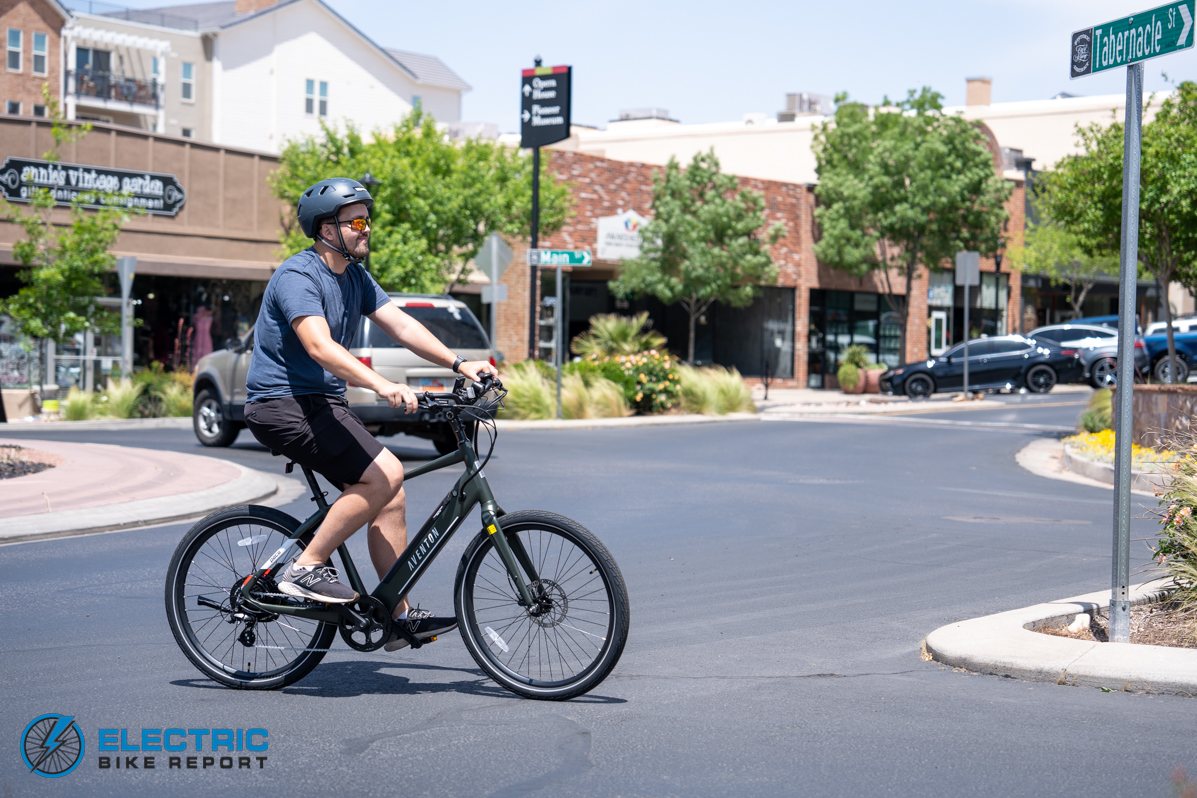
Nimble handling and great maneuverability are excellent features on an urban-friendly bike.
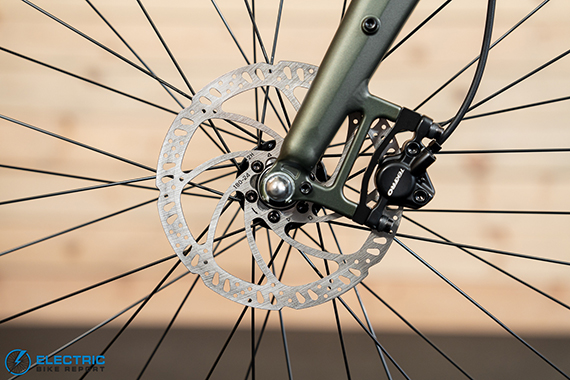
We’ve had great results from the Tektro E350 hydraulic disc brakes that the Pace is equipped with.
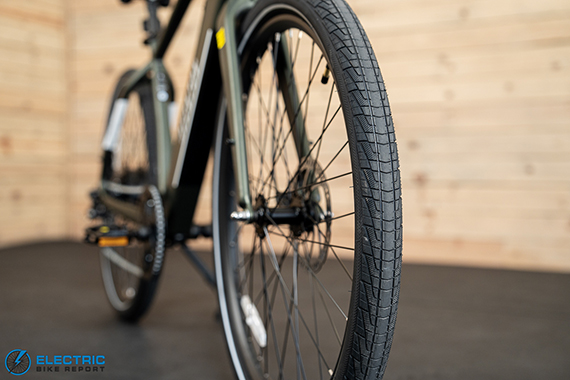
The 27.5” x 2.1” tires are fast rolling and puncture-resistant, though they did skid easily when braking.
Ultimately, the Pace 500.3 felt much better on hills than its results here might suggest; even in Eco mode, it was able to power up some difficult inclines. Considering its performance on Hell Hole Trail, we feel confident in saying that, while you may need to contribute a relatively small amount of effort, the bike can handle even uncommonly steep slopes confidently.
It’s worth noting that the other bikes we are using for comparison purposes here also have 500W rear-hub motors, but they use cadence sensors instead of torque sensors. E-bikes with the Pace 500.3’s configuration are (at time of writing) still relatively uncommon, especially in the price range of between $1,500 and $2,000. It is likely, at least on the maximum PAS portion of our Hill Test, that other e-bikes with torque sensors and the same size motor would show similar results, but we currently don’t have enough of those to compare with to say with certainty.
Aventon Pace 500.3 HS Review: Safety and Brake Test
The bike ships with Tektro E-350 hydraulic disc brakes on 180mm rotors, which we have had consistently good experiences with – even on heavier e-bikes. Their performance was reliable in this test as well, with an average stopping distance of 20’-5”. Despite being slightly longer than our result for the Step-Thru version of the bike we recently reviewed, this result was still better than average when compared to other similar e-bikes we’ve tested. The pool of similar e-bikes is fairly small, however; most differ in terms of size, weight, brake type, etc. Speaking more broadly, the Pace 500.3’s results were better than our current running average across all of the e-bikes we have data for, which is, at time of writing, roughly 21’-4”. We are quite satisfied with these results, which show that the bike’s brakes are able to both slow and stop it quickly.
However, there was one aspect of the bike’s braking that was somewhat less desirable. When riding around in the late spring weather here in southern Utah, the mixed-use paths where we test e-bikes are populated with lizards that, like land mines, we do our best to avoid. When braking hard to dodge kamikaze-style sprints from these rambunctious reptiles, we noticed the Pace 500.3 had a tendency to skid alarmingly; I personally struggled to maintain control on a few occasions. I believe this behavior to primarily be a result of the low street tread on the bike’s 27.5″ x 2.1″ tires, but there may have been environmental factors like dust or pea gravel present as well; regardless, it’s something to be aware of.
I’ve discussed the Pace 500.3’s taillights, brake lights, and turn signals at length, however, there is also a small but bright headlight equipped on the bike. Aside from reflectors, that covers all of the bike’s safety features.
Aventon Pace 500.3 HS Review: Ride Comfort & Handling, Cockpit, and More
The Pace 500.3’s contact points are much more cruiser-styled than most of the other e-bikes in the Aventon lineup. Instead of the standard wedge-shaped Aventon saddle, the Pace includes a thicker and more rounded seat. The bike’s pedals are fairly standard, but the handlebars are expectedly swept back. I’m not typically a fan of cruiser-style bikes because of their handlebars and the wrist angle required to steer them, but aside from feeling like the handlebars on the Pace 500.3 were a bit too narrow for my frame, their sweep was much more comfortable than I expected!
The bike uses ergonomic rubber grips that were comfortable but not out-of-the-ordinary; however, they allowed the bike to feel much more nimble and maneuverable than expected when considering its large 27.5” wheels. I found that the natural wrist/hand placement of the bike’s handlebars allowed me to use the supportive “wings” of the grips as leverage points when cornering, and that enabled for tighter turns and more responsive handling overall.
We enjoyed the cockpit layout as well, as it distributed controls effectively. The bike’s thumb-operated throttle lever and control panel were mounted to the left handlebar, with an under-the-bar trigger shifter on the right bar. All of these elements are common components we’ve seen on many of the other Aventon e-bikes we’ve tested, and they’ve been consistently good in our experience. Similarly, the Pace 500.3’s display is standard, but we appreciate its layout, organization, and color scheme.
Overall, I found the bike to be comfortable, maneuverable, and easy to operate – all things that were a pleasant surprise considering that I personally tend to be less enthusiastic about cruiser-style e-bikes in general. The Pace 500.3 has been one of the best I’ve experienced!
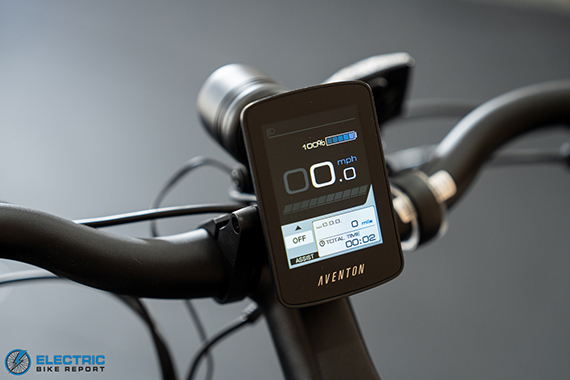
The standard Aventon LCD is well-organized, colorful, and easy to follow.
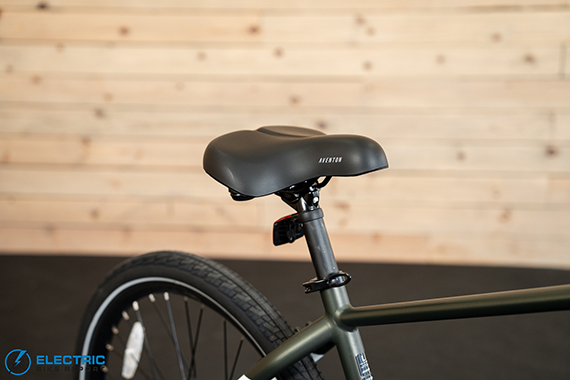
In contrast to other Aventon e-bikes, the Pace 500.3 features a more padded cruiser-style saddle.
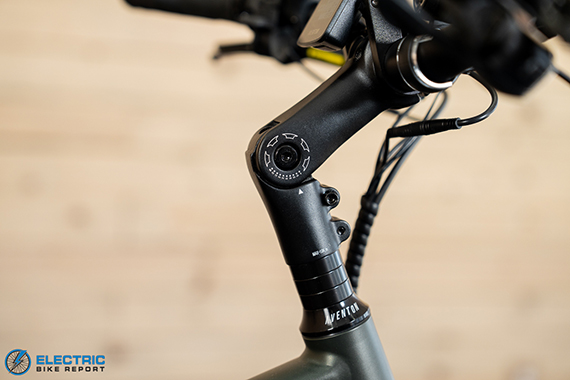
An adjustable stem allows you to set the height and reach that works best for you!
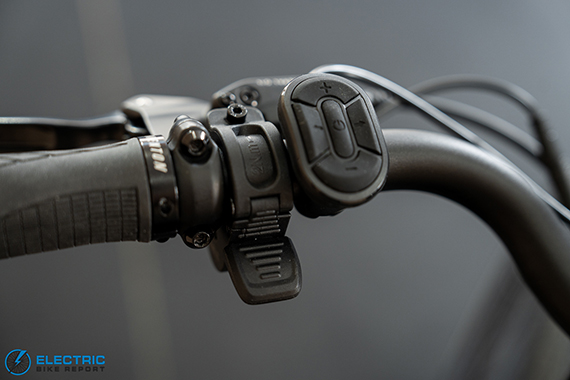
The bike’s throttle lever, turn signals, and PAS adjustment buttons are all easy to reach from the left grip.
Aventon Pace 500.3 HS Review: Summary / Where to Buy
The addition of the bike’s torque sensor has greatly improved its general feel, its motor’s responsiveness and efficiency, and the distance it can travel. And the addition of turn signals makes it safer and more effective for street use as a commuter and even on casual neighborhood rides.
We might prefer to see tires with more heavily textured tread to reduce the likelihood of sliding out when braking hard. And despite liking the layout of the Pace 500.3’s display, it could be a bit difficult to read in the middle of the day, at least here in the sunny desert where we test e-bikes.
Those couple of critiques aside, we think Aventon nailed this new-and-improved version of the bike, and we think it’s a great fit for riders of all shapes and sizes who might find a relatively lightweight, cruiser-style e-bike appealing.
Happy Riding! Make sure to let us know if you have any questions down in our comments section or if you think we left anything out in this review of the Aventon Pace 500.3 HS.





Thank you for this great review. It sounded like the ideal e-bike for my preferences with the relatively light weight, adjustable stem, swept handlebars, and torque sensor. I could not find this combo on any other competitors for under $2000. So, I rented one at a local dealer and liked it enough to buy it there when the price dropped to $1699 with a $200 accessory credit. The credit covered the purchase of some extras found on similarly priced bikes, like rack and fenders. Happy to support a local dealer for only $50 assembly charge and nice to see Aventon also supporting them by offering their website promotions with a proof of proof of purchase at an authorized dealer.
Glad you found our review helpful! Enjoy your new e-bike!
I ended up getting it for similar reasons to others, price, weight, range and power balance of this bike. I really enjoy how well rounded it is. I do still wish for some things like more power and a suspension fork, but they would like add weight and costs. Will be enjoying my 500.3 and waiting to see if a Pace 750 comes out in the future.
I find that in 2nd and 3rd gear it feels like the chain frequently -slips” a bit. Is there any kind of adjustment to fix that?
It’s possible that your derailleur may need to be adjusted, there should be screws that change its limits. I recommend searching on YouTube for your specific derailleur model!
Great specs but man it looks like something my grandparents would ride. Aventon needs to get a better designer
I enjoyed your review but I can’t find any information on the torque nm’s for the 500W motor, and the name of the motor.
Thanks.
Ahoy, Captain! The Pace 500.3’s motor is custom-branded, so we’re not sure what company manufactures it. We know it has 60 Nm of torque.